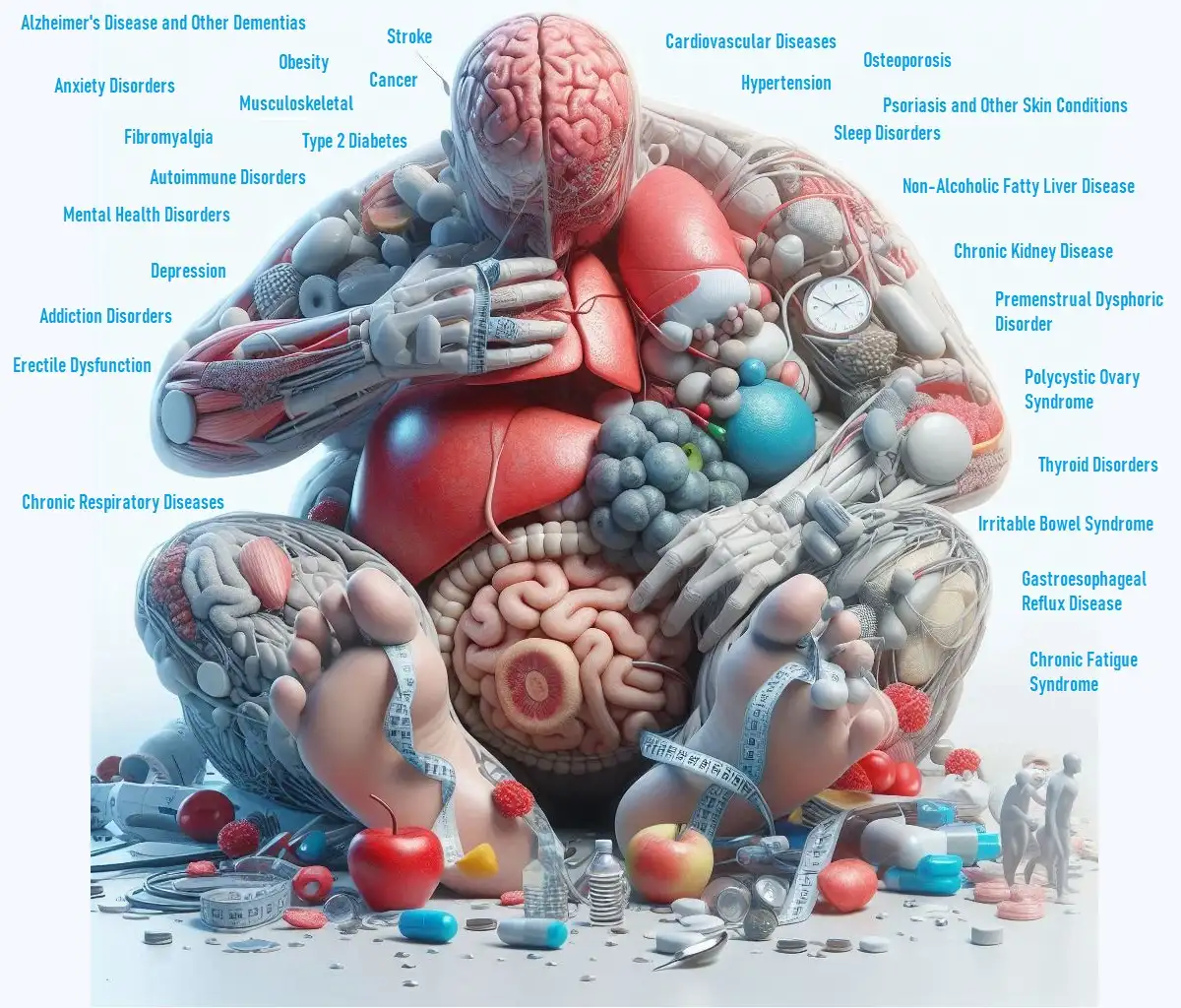
Living with carpal tunnel syndrome, chronic back pain, or arthritis can be incredibly challenging. Understanding how ergonomics, diet, and obesity affect these conditions can help you manage symptoms more effectively and improve your quality of life. This article explores the impact of ergonomics on carpal tunnel syndrome, the relationship between chronic back pain and sleep disturbances, the role of an anti-inflammatory diet in managing arthritis, how obesity impacts joint health, and the connection between carpal tunnel syndrome and nerve compression.
Key Takeaways
- Ergonomics and Carpal Tunnel Syndrome: Proper ergonomic practices can help prevent and alleviate carpal tunnel syndrome.
- Back Pain and Sleep: Chronic back pain can lead to significant sleep disturbances.
- Anti-Inflammatory Diet: Eating an anti-inflammatory diet can help manage arthritis symptoms.
- Obesity and Joint Health: Extra weight can put additional stress on your joints, worsening pain and mobility.
- Nerve Compression: Carpal tunnel syndrome involves nerve compression in the wrist, leading to pain and numbness.
Impact of Ergonomics on Carpal Tunnel Syndrome
What is Carpal Tunnel Syndrome?
Carpal tunnel syndrome (CTS) is a condition caused by pressure on the median nerve in the wrist. This nerve controls sensation and movement in the hand, and when compressed, it can lead to pain, numbness, and weakness in the hand and fingers.
How Ergonomics Play a Role
- Proper Desk Setup: Using an ergonomic chair and desk can reduce strain on your wrists. Ensure your keyboard is at a comfortable height to keep your wrists in a neutral position.
- Wrist Positioning: Avoid bending your wrists while typing or using a mouse. Keep them in a neutral position to minimize pressure on the carpal tunnel.
- Breaks and Exercises: Regular breaks from repetitive tasks and wrist exercises can prevent CTS. Stretching and strengthening exercises help maintain wrist flexibility and strength.
Practical Tips
- Adjust Your Workspace: Set up your workstation so that your elbows are at a 90-degree angle, and your wrists remain straight.
- Use Ergonomic Tools: Invest in ergonomic keyboards, mouse pads, and wrist supports to reduce strain.
- Mind Your Posture: Maintain a good posture to support overall body alignment and reduce pressure on your wrists.
Chronic Back Pain and Sleep Disturbances
The Connection Between Back Pain and Sleep
Chronic back pain can severely impact your sleep quality. Here’s how:
- Difficulty Finding a Comfortable Position: Persistent pain can make it hard to find a comfortable sleeping position, leading to restless nights.
- Disrupted Sleep Cycles: Pain can cause frequent awakenings, disrupting your sleep cycle and reducing the quality of rest.
- Impact on Overall Health: Poor sleep can worsen back pain and contribute to other health issues, including mood disturbances and reduced cognitive function.
Strategies for Better Sleep with Chronic Back Pain
- Mattress and Pillow Choices: Invest in a supportive mattress and pillow that align your spine properly.
- Sleep Positions: Try sleeping on your side with a pillow between your knees or on your back with a pillow under your knees to relieve pressure on your back.
- Pain Management: Use pain relief methods such as heat therapy or prescribed medications before bedtime to manage pain and improve sleep quality.
Role of Anti-Inflammatory Diet in Managing Arthritis
What is an Anti-Inflammatory Diet?
An anti-inflammatory diet focuses on reducing inflammation in the body, which can help manage arthritis symptoms. It emphasizes:
- Fruits and Vegetables: These are rich in antioxidants, which can help reduce inflammation.
- Healthy Fats: Foods like olive oil and fatty fish contain omega-3 fatty acids, which have anti-inflammatory properties.
- Whole Grains: Whole grains such as brown rice and oats provide essential nutrients and fiber, which can support overall health.
Benefits for Arthritis Management
- Reduced Joint Pain: A diet rich in anti-inflammatory foods can help reduce joint pain and stiffness.
- Improved Function: Consuming anti-inflammatory foods can support joint function and mobility.
- Overall Health: This diet can improve overall health, which can indirectly benefit joint health and reduce arthritis symptoms.
Practical Dietary Tips
- Incorporate Omega-3s: Include more fatty fish like salmon or supplements to reduce inflammation.
- Eat a Rainbow: Consume a variety of colorful fruits and vegetables to ensure a wide range of antioxidants.
- Limit Processed Foods: Avoid foods high in sugars and saturated fats, which can promote inflammation.
Impact of Obesity on Joint Health
How Obesity Affects Your Joints
Carrying excess weight puts extra stress on your joints, particularly those in the lower body. This added pressure can:
- Worsen Pain: Increased weight can exacerbate joint pain and discomfort.
- Accelerate Joint Degeneration: Extra weight can lead to faster degeneration of joint cartilage, worsening conditions like osteoarthritis.
- Reduce Mobility: Joint pain and stiffness from obesity can limit mobility and physical activity.
Managing Weight for Joint Health
- Balanced Diet: Focus on a diet that supports healthy weight management, including plenty of fruits, vegetables, lean proteins, and whole grains.
- Regular Exercise: Engage in low-impact exercises such as swimming or walking to reduce joint stress and support weight loss.
- Consult Professionals: Work with a healthcare provider or dietitian to create a personalized plan for weight management and joint health.
Carpal Tunnel Syndrome and Nerve Compression
Understanding Nerve Compression in CTS
Nerve compression in carpal tunnel syndrome occurs when the median nerve is squeezed within the carpal tunnel of the wrist. This compression can:
- Cause Pain and Numbness: Pressure on the nerve can lead to pain, tingling, and numbness in the hand and fingers.
- Lead to Weakness: Prolonged compression can weaken hand muscles and reduce grip strength.
Treatment and Management
- Wrist Splints: Wearing wrist splints can keep the wrist in a neutral position and relieve pressure on the nerve.
- Ergonomic Adjustments: As mentioned, making ergonomic adjustments can prevent and alleviate symptoms.
- Medical Intervention: In severe cases, medical treatments such as corticosteroid injections or surgery may be required to relieve nerve compression.
Practical Tips
- Regular Monitoring: Keep track of symptoms and consult your healthcare provider regularly.
- Early Intervention: Seek early treatment to prevent long-term damage and improve outcomes.
Conclusion
Managing carpal tunnel syndrome, chronic back pain, arthritis, and the impact of obesity on joint health involves a combination of ergonomic adjustments, dietary changes, and weight management strategies. Understanding these connections can help you take proactive steps to alleviate symptoms and improve your overall quality of life. By making informed choices and seeking appropriate medical care, you can effectively manage these conditions and enhance your wellbeing.















